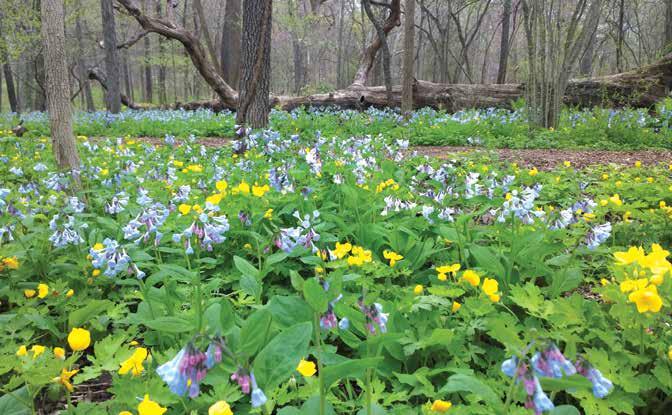
2 minute read
When Spring Wildflowers Bloom like Crazy
There is a correlation between winter freeze and spring bloom. When winters are consistently cold and the ground is frozen for longer periods, spring floral display is at its best. When winters are warmer, and the ground is mostly wet, rather than frozen, flower displays suffer. I’m talking about early spring-blooming wildflowers like celandine poppy (Stylophorum diphyllum), Virginia bluebells (Mertensia virginica), Jacob’s ladder (Polemonium reptans), wild geranium (Geranium maculatum), columbine (Aquilegia canadensis), bellflower (Uvularia grandiflora), sweet William (Phlox divaricata), dwarf larkspur (Delphinium tricorne), crested iris (Iris cristata), Solomon’s plume (Smilacina racemosa), mayapple (Podophyllum peltatum), Palmer’s spiderwort (Tradescantia ernestiana), yellow violet (Viola pubescens), wood lily (Trillium recurvatum), and round-leaved groundsel (Packera obovata). Bloom quality and plant vigor decline after unusually warm winters.
One reason behind this is that soil drains poorly in this cool, unfrozen environment. Persistent wet soil causes enough root rot to impact plant performance, but usually not enough to kill it. It’s not warm enough to dry the soil, and not cold enough to keep it frozen. Also, plants are not actively growing and pulling moisture out of the soil. The problem gets worse when we have rainy winters.
What is a gardener to do? Not much, unfortunately. Keep leaves from gathering into piles in the areas where you have wildflower displays. Spread the leaf litter out evenly or remove some of it in fall, when the leaves first come down. Leave them alone for the remainder of winter and spring. Remember that keeping leaf litter is important to promote overwintering insects like luna moths and great spangled fritillaries.
Also use the right plant in the right location. If you have poorly drained, moist soil shaded by trees, plant moist-loving shade species like rose turtlehead (Chelone obliqua), purple Joe Pye (Eutrochium purpureum), garden phlox (Phlox paniculata), sensitive fern (Onoclea sensibilis), red buckeye (Aesculus pavia), hop sedge (Carex lupulina), and golden groundsel (Packera aurea). These plants thrive when soil stays wet.
In a changing world where winters are milder, and wetter, expect surprises. As I write this in early January, Ozark witch hazel is in full bloom. It normally blooms in February or March. Earlier in winter, I saw an unusual number of butterflies and bees flying around. Spring wildflower displays change from year to year, because they are at the mercy of winter weather, among other things like root-eating voles. When wild geranium and celandine poppy bloom poorly, remember, it isn’t your fault. Try to be patient and look on the bright side, because they will probably come back a year or two later, blooming like crazy.
Yellow celandine poppy with Virginia bluebell
Round leaved groundsel and spring daisy

SCOTT WOODBURY Horticulturist
Horticulturist Scott Woodbury is the Curator of the Whitmore Wildflower Garden at Shaw Nature Reserve in Gray Summit, Missouri, where he has worked with native plant propagation, design, and education for 30 years. He also is an advisor to the Missouri Prairie Foundation’s Grow Native! program. Find suppliers of native plants and seeds at www.grownative.org, Resource Guide.






